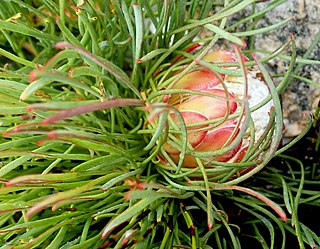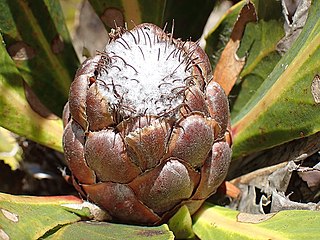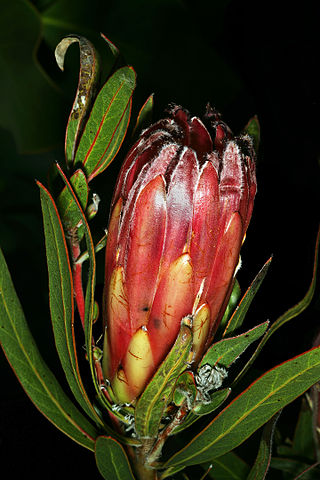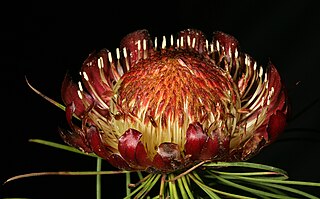
Protea is a genus of South African flowering plants, also called sugarbushes. It is the type genus of the Proteaceae family.

Protea magnifica, commonly known as the queen protea, is a shrub, which belongs to the genus Protea within the family Proteaceae, and which is native to South Africa.

Protea effusa, sometimes known as the scarlet sugarbush, is a flowering plant which belongs to the genus Protea. The plant is endemic to the Western Cape province of South Africa. In the Afrikaans language the vernacular name blosrooisuikerbos has been recorded for this plant.

Protea pendula, also known as the nodding sugarbush or arid sugarbush, is a flowering plant of the genus Protea, in the family Proteaceae, which is only found growing in the wild in the Cape Region of South Africa. In the Afrikaans language it is known as knikkopsuikerbossie or ondersteboknopprotea.

Protea recondita, also known as the hidden sugarbush, is a flowering plant of the genus Protea within the family Proteaceae, which is endemic to the Cape Region of South Africa, and distributed from the Piketberg and Cederberg to the Groot Winterhoek mountains. The flowers of this unusual plant are pollinated by non-flying mammals: rodents and elephant shrews. In the Afrikaans language it is known as gesigtoehouprotea or skaamroos.

Protea sulphurea, also known as the sulphur sugarbush, is a flowering plant of the genus Protea in the family Proteaceae, which is only known to grow in the wild in the Western Cape province of South Africa. A vernacular name for the plant in the Afrikaans language is heuningkoeksuikerbos or Skaamblom.

Protea intonsa, also known as the tufted sugarbush, is a flowering plant of the genus Protea within the family Proteaceae, endemic to South Africa, where it is distributed from the eastern Swartberg and Kammanassie Mountains to the Baviaanskloof mountains. In Afrikaans it is known as klossie-suikerbos.

Protea montana also known as the Swartberg sugarbush, is a flowering plant of the genus Protea within the family Proteaceae, which is endemic to the southwestern Cape Region of South Africa. In Afrikaans it is known as swartbergsuikerbos.

Protea vogtsiae, also known as the Kouga sugarbush, is a small flowering shrub of the genus Protea within the family Proteaceae, which is only found growing in the wild in the southern Cape Region of South Africa.

Protea pudens, also known as the bashful sugarbush, is a low-growing, groundcover-like, flowering shrub in the genus Protea. It is only found growing in the wild in a small area in the Western Cape province of South Africa.

Protea burchellii, also known as Burchell's sugarbush, is a flowering shrub in the genus Protea, which is endemic to the southwestern Cape Region of South Africa.

Protea speciosa, also known as the brown-beard sugarbush, is a flowering shrub which is classified as within the genus Protea.

Protea witzenbergiana, or Swan sugarbush, is a flowering shrub of the genus Protea.

Protea pityphylla, also known as Ceres sugarbush or mountain rose, is a flowering shrub of the genus Protea, in the family Proteaceae. The plant is endemic to the southwestern Cape Region of South Africa.

Protea canaliculata, also known as the groove-leaf sugarbush, is a species of flowering shrub of the genus Protea, which is endemic to the Cape Provinces of South Africa.

Protea pruinosa, also known as frosted sugarbush or burnished protea, is a flowering shrub which belongs to the genus Protea within the botanical family Proteaceae. The plant is endemic to the southwestern Cape Region of South Africa.

Protea lorifolia, in English called the strap-leaved sugarbush, strap-leaved protea or strap-leaf sugarbush is a flowering shrub which belongs to the genus Protea.

Protea convexa, also known as large-leaf sugarbush, is a rare flowering shrub in the genus Protea of the family Proteaceae, which is endemic to the southwestern Cape Region of South Africa.

Protea punctata, also known as the water sugarbush or water white sugarbush, is a shrub belonging to the genus Protea which is found growing in the wild in South Africa.

Protea decurrens, also known as linear-leaf sugarbush, is a shrub of the genus Protea, in the Proteaceae family, which is endemic to the southwestern Cape Region of South Africa. It is a small shrub with a thick underground rootstock, this structure throwing up numerous leafy branches, upon the base of which clusters of flower heads may appear close to the ground. It is pollinated by rodents and grows in low-altitude fynbos or renosterveld.





















